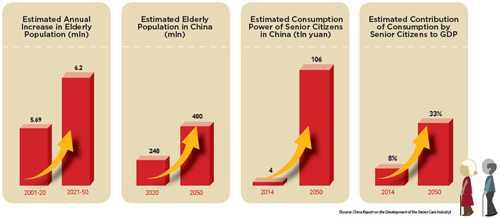|
According to the report, by 2020, China will have 29 million people aged 80 and above, and the group will reach its peak in 2054, standing at a considerable 118 million.
Therefore, the senior care industry must focus on this section of the population. "The number of senior citizens unable to take care of themselves will also increase dramatically, reaching 47 million by 2020 and surpassing 100 million in 2053. This will engender a huge market for the industries of appliances, services and real estate," said Dang Junwu, Deputy Director of the CRCA.
The number of empty nesters and the childless is also growing, and may reach 79 million by 2050. "Demand for services by such elderly citizens will be particularly robust, and this will stimulate development of the industries of appliances and real estate for the elderly. Providing salable products and services for them will be a large market to be developed," said Dang.
According to the report, there will be a large increase in demand for healthcare services by senior citizens. It is estimated that among all the senior residents, the number of chronically ill will rise from 110 million to 300 million in 2050, and the healthcare consumption of senior citizens will account for at least 5 percent of the country's GDP. Behind these figures lies a huge potential healthcare consumption market.
The report states that in the future China's aging population will be better educated than previous generations of seniors; therefore, the design of products as well as supply of services and real estate must incorporate to a greater degree the cultural tastes of senior citizens. "This will also boost upgrading of the senior care industry, which may bring unlimited business opportunities," Dang added.
Financial innovation
Among the four categories of the senior care industry, financing should be accorded the most precedence.
In Western countries, senior care financing is an important part of the modern financial system, and developing senior care financing represents a priority for the financial industry. "For instance, in the United States, among the 6.21 million people working in the financial industry in 2012, 60 percent were engaged in senior care financing," Dang said.
At present, China's senior care financing industry is facing problems such as a low level of awareness of the financial needs of ordinary people, a lack of supply to meet the present demand for senior care financial products and an underdeveloped senior care financial market. Therefore the industry must change their strategies and establish a new type of financial system appropriate to the senior care economy.
"In the long term, China is less prepared in the financial sector for the challenges of the aging population," said Wang Haitao, Deputy Director of the Strategic Institute of the CRCA, adding that improving the senior care financial system not only serves to meet the demand for development of the senior care industry, but also an important measure to consolidate economic reform, reinvigorate the national economy and build new engines for economic growth.
Despite the advanced years of its target market, China's senior care financing is still in its infancy. Banking deposits are still favored by senior citizens over financial products, despite the fact that this remains an ineffective investment choice, which reflects the dearth of attractive senior care financial products.
The report forecasts that as the Chinese economy further grows, banking, insurance, investment funds and securities companies have become aware of the opportunities and challenges brought by the aging population.
"The industry must reorganize various resources and diversify financial products targeted at the elderly, so as to establish a diversified, multi-level, consumer-oriented and balanced structure for a sustainable senior care financial industry and facilitate the sound development of the Chinese financial industry in an aging society," said Wang.
Email us at: wangjun@bjreview.com

| 